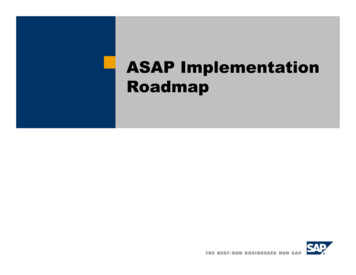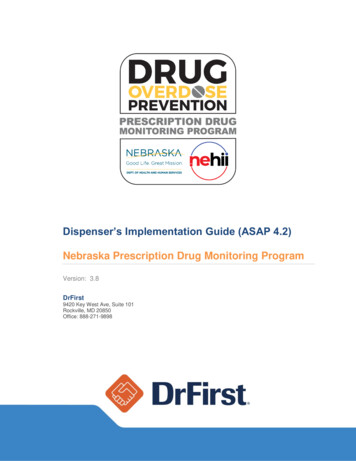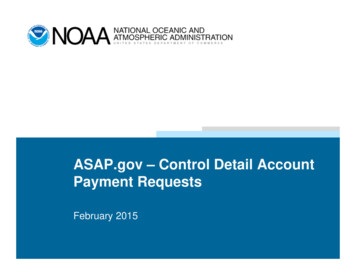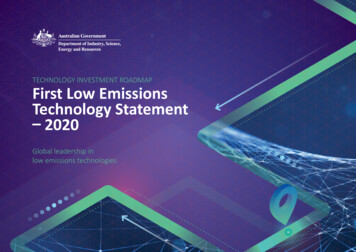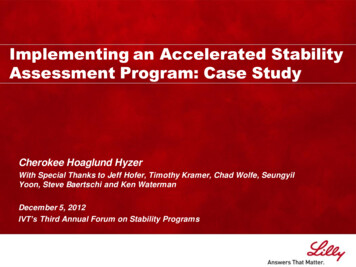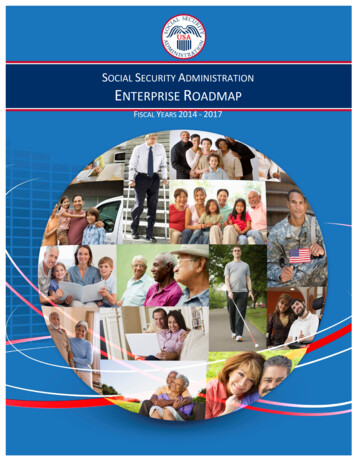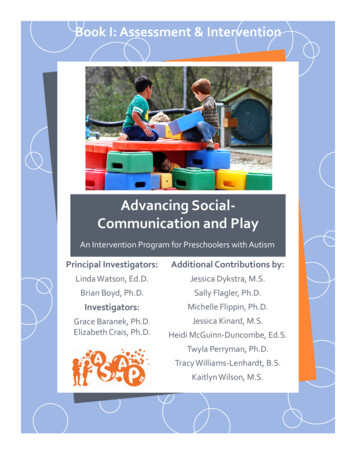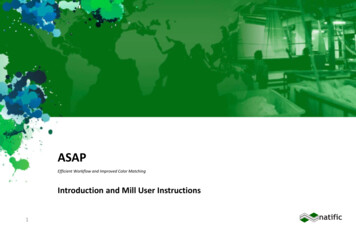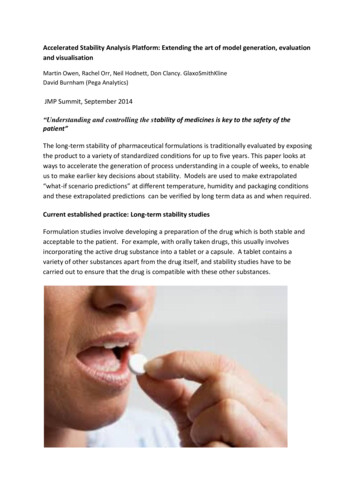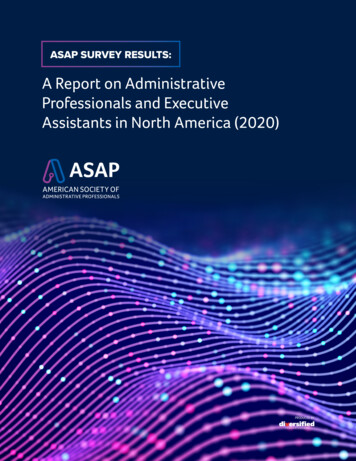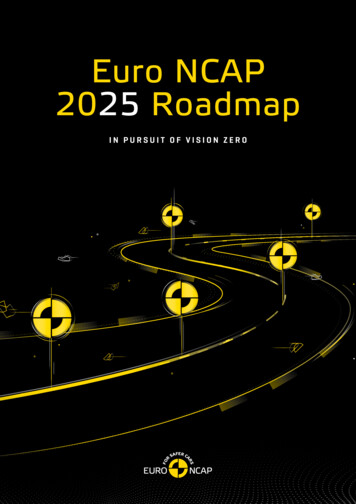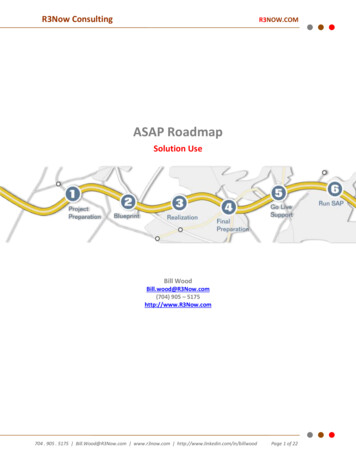
Transcription
R3Now ConsultingR3NOW.COMASAP RoadmapSolution UseBill WoodBill.wood@R3Now.com(704) 905 – 5175http://www.R3Now.com704 . 905 . 5175 Bill.Wood@R3Now.com www.r3now.com http://www.linkedin.com/in/billwoodPage 1 of 22
R3Now ConsultingR3NOW.COMContentsTHE SAP ASAP METHODOLOGY ROADMAP . 3Objectives . 3Background . 3My Experiences with ASAP . 4Included in this Package. 4ASAP Roadmap Navigation Options. 4USING THE ASAP ROADMAP . 5Accessing the Online HTML version . 5PROJECT AND PROGRAM MANAGEMENT . 60.0 ASAP Methodology Starting Point . 60.0 Phases: Purpose, Deliverables, Milestones / Key Decisions . 61.1.3 Get it Right from the Start . 71.1.4 Execution, Monitoring, and Controlling Project Results . 9ENSURING QUALITY, CONSISTENCY, AND RESULTS . 101.1.6.2 Project Quality Gates . 10DIFFERENT ROADMAP OPTIONS – AGILE, CRM, BI/BW, ETC. . 12CHANGE MANAGEMENT, DATA MANAGEMENT & TECHNICAL SOLUTIONS . 141.2.3 (ASAP v. 7.1) – Change Management Project Planning . 15DATA MANAGEMENT. 161.4.1 Data Migration Workshop . 161.4.2 Data Audit . 162.5.3.2 General Settings and Master Data . 176.2 Governance Model. 196.2.1 Maturity Model . 19APPENDIX A . 21Helps, Tips, Tricks, and Resources . 21Internal SAP Resource Online Support System Access (OSS access) . 21Additional ASAP Resources . 22704 . 905 . 5175 Bill.Wood@R3Now.com www.r3now.com http://www.linkedin.com/in/billwoodPage 2 of 22
R3Now ConsultingR3NOW.COMTHE SAP ASAP METHODOLOGY ROADMAPObjectivesThe overall objective is to begin to gain an understanding how to use this SAP provided resource (free toSAP customers) to accelerate project delivery at a lower cost and higher quality. Gain basic insight into the use of the ASAP RoadmapBriefly review a few selected project accelerators (tools, resources, and templates)Understand the Project Quality ControlsDo a quick overview of the Center of Expertise / Excellence resources in the Phase 6 Run portionIf time permits do a short overview of the other major ASAP components (there is MUCH morethan just the roadmap we will review here).BackgroundIn the mid 1990’s SAP had gained a significant amount of bad press and publicity around several highprofile project disasters that the company knew were completely avoidable. At that time Oracle, Baan,JD Edwards, and PeopleSoft all had sales people making the case that SAP was too expensive, toocomplicated, and took too long to implement. In response ASAP was originally released in the mid-late90’s (around 1996 or 1997) because of the number of SAP projects that were going over time and overbudget. It has been refined, polished, enhanced, and adjusted with SAP’s supported R&D resources andefforts for about 15 years now.The ASAP implementation methodology has leveraged the PMI (Project Management Institute)best practices around project delivery and the Carnegie Mellon CMMI (Competency MaturityManagement Integration) approach for maturing the delivery process. The ASAP methodologyalso includes a number of ITIL (Information Technology Infrastructure Library) components in thePhase 6 Run and the ValueSAP portions of the methodology. Agile techniques are an optionwhich can be “turned on” if you like.The toolset includes an implementation “Roadmap” which is a WBS based project template. It has fullexplanations, templates, tools, resources, checklists, etc. Together with that the original version alsoincluded an MS Access, and then an MS SQL Database application for selecting your solution optionswhich would then generate a list of processes, transactions codes, template BPPs, and a full SAPcentered Blueprint document, etc.Today all of that functionality is still available but it is housed in Solution Manager. The ASAPRoadmap is just ONE component of the entire ASAP Methodology. The Roadmap is focused oneffective Program or Project Management for accelerated project delivery with high qualityresults.704 . 905 . 5175 Bill.Wood@R3Now.com www.r3now.com http://www.linkedin.com/in/billwoodPage 3 of 22
R3Now ConsultingR3NOW.COMMy Experiences with ASAPI was originally certified in ASAP back in 1998 while at Grant Thornton. In that time I have had theprivilege of using ASAP on several projects and as the project manager on a few. One consistent resultof using the methodology is that projects are delivered and they are usually delivered on time and onbudget (although not always).I have only ever seen significant problems with ASAP when a system integrator started to use themethodology and then abandoned it part way through the project. At a Steelcase subsidiary (PolyVisionin John’s Creek) we used it as the framework to develop a LEAN implementation methodology. ThatLEAN methodology has served as an ongoing framework to significantly accelerate numerous rollouts atprobably 25% of the normal implementation cost of other SAP projects.Included in this PackageI have put together an ASAP Roadmap “toolkit” for your future use and reference. It can be run fromthe disk directly or it can be copied to your computer. Please keep in mind that SAP has spent literallyover 100 million dollars over the years in R&D for this methodology and across the roadmaps I amproviding (which is NOT complete) there are well over 200,000 files. So if you copy it to your machineexpect it to take quite some time.This is just a guide with various highlights on using the ASAP Methodology Roadmap, it is not meantto be a comprehensive overview.ASAP Roadmap Navigation OptionsWBSstructuredRoadmapTemplates,tools, ncesDifferentRoadmapTypesKey usageinstructionsand guidance704 . 905 . 5175 Bill.Wood@R3Now.com www.r3now.com http://www.linkedin.com/in/billwoodPage 4 of 22
R3Now ConsultingR3NOW.COMUSING THE ASAP ROADMAPAccessing the Online HTML versionOnce you have you SAP OSS Logon you can go directly to the latest online (HTML) version of ASAP at:http://service.sap.com/asap . You will be prompted for your credentials and they should automaticallybe selected after you have signed up for the Single Sign-on.The basic premise of ASAP relies on 6 phases of IT project delivery:1. Project Prep – Critical foundations around planning and setting the stage for a successfulproject.2. Blueprint – Business assessment of the system state which leads to the “To Be” documentedstate.3. Realization – Key execution activities around delivering the future “To Be” solution.4. Final Prep – Getting ready for the data conversions, training, and transition to a new system.5. Go-Live – The actual transition to the new system.6. Run – Post production support, long term IT delivery maturity, andSome vendor versions of this methodology re-name the phases and condense them to 4 phases. Theyusually combine Project Prep and Blueprint into 1 phase and then completely ignore the Run phase 0.0 While we will not review the entire ASAP Methodology and Toolset today, you can see SAP’soverview of the resources and their purpose 4 . 905 . 5175 Bill.Wood@R3Now.com www.r3now.com http://www.linkedin.com/in/billwoodPage 5 of 22
R3Now ConsultingR3NOW.COMPROJECT AND PROGRAM MANAGEMENT0.0 ASAP Methodology Starting re you open the first WBS item in the methodology SAP provides a several accelerators to use. Forexample, on the first page you have an example project plan which has been refined through manyyears of ASAP use. It comes in an MS Excel format and a Microsoft Project format:0.0 Phases: Purpose, Deliverables, Milestones / Key ors/ASAP%20Roadmap%20Phases%20Descriptions.pptThis presentation is the “overview” guide of ASAP that provides a great starting framework for keyproject activities.704 . 905 . 5175 Bill.Wood@R3Now.com www.r3now.com http://www.linkedin.com/in/billwoodPage 6 of 22
R3Now ConsultingR3NOW.COM1.1.3 Get it Right from the StartEven before the first consultant comes on board the ASAP methodology provides templates andresources to cover key project and program management areas such as communication planningdecision makingrisk managementproject management master planningresource planningsteering committee toolsexternal links to best practice resources for reference (see the PMI body of knowledge ref).2.1.1 And then as you “exit” the project prep phase one of the first steps in the next phase provides youwith a “checklist” tool to ensure all of the key items are in place for success. The setup checklist sampleSAP provides has a good introduction and example at the end. This checklist works well on Agile, Lean,Rollout, and other types of ors/Project%20Setup%20Checklist Sample.doc704 . 905 . 5175 Bill.Wood@R3Now.com www.r3now.com http://www.linkedin.com/in/billwoodPage 7 of 22
R3Now ConsultingR3NOW.COM1.1.2.3 A more detailed project “checklist” that may be useful for defining the various work packagesthat are needed for each type of project, or subproject, to support Agile methods. For example you maycheck off only a few of the key work packages and requirements for a small release that needs only acouple of people but a much more comprehensive approach may be needed for a larger rs/Scope%20Verification%20Matrix Sample.xls1.1.5 The project standards with working documents, templates, explanations, and other resources areprovided from the start of the project (during project prep).704 . 905 . 5175 Bill.Wood@R3Now.com www.r3now.com http://www.linkedin.com/in/billwoodPage 8 of 22
R3Now ConsultingR3NOW.COM1.1.4 Execution, Monitoring, and Controlling Project ResultsHigh Performance Project Delivery from the StartRight from the beginning oversight and delivery performance are built into the Roadmap. Before thefirst project execution activities take place it is possible to start off with the key oversight items for asuccessful project with the lowest Total Cost of Implementation (TCI).DeliverablesThe outputs of this deliverable are: Project performance reports, including:Team member status reportsProject status reportsExecutive status reportsQuarterly operations reviewsProject budget updatesApproved change requestsChange control log updatesIssue log updatesRefined WBS and WBS dictionaryProject schedule and blueprint workshop scheduleRequests for changeScope statement updatesScope verification matrix updatesProject schedule updatesRisk register updatesCommunication matrix updatesTeam member evaluations (non-SAP resources)Team member appraisals (SAP resources)704 . 905 . 5175 Bill.Wood@R3Now.com www.r3now.com http://www.linkedin.com/in/billwoodPage 9 of 22
R3Now ConsultingR3NOW.COMENSURING QUALITY, CONSISTENCY, AND RESULTS1.1.6.2 Project Quality GatesOne of the critical features of the ASAP Methodology are the quality gate checks. These help to ensurethe project is delivered correctly, within the expected timeframe, with good results, and with areasonable Total Cost of Implementation (TCI). For more detailed information on the SAP Quality Gateapproach you can review the following iew Presentation.pptxThe overview presentation above, on slide 7, provides a great summary of the Quality Gate approach:Project Quality Gate means Formal assessment of the quality and integrity of the project deliverablesFormal checklists are used throughout the life of a projectFormal sign-off and acceptance occurs at each gateMeasure customer satisfaction throughout the projectInformation is assured to be communicated to the correct stakeholders during theprojectPurpose and ImpactThe intention of Q-Gates is to ensure that when we reach significant milestones in the projectwe check the Quality of the delivery: Are we on track?Are all deliverables complete?Are they fit for purpose?Do the Partner/Customer agree?Is risk managed?Can we start the next phase without delayThe ASAP Methodology defines 4 Q-Gate quality checks as mandatory and 3 additional ones as optional.704 . 905 . 5175 Bill.Wood@R3Now.com www.r3now.com http://www.linkedin.com/in/billwoodPage 10 of 22
R3Now ConsultingR3NOW.COMThe actual Q-Gate scorecard template can be found 04 . 905 . 5175 Bill.Wood@R3Now.com www.r3now.com http://www.linkedin.com/in/billwoodPage 11 of 22
R3Now ConsultingR3NOW.COMDIFFERENT ROADMAP OPTIONS – AGILE, CRM, BI/BW, ETC.Since shortly after its creation the ASAP methodology has supported the various SAP applications.However the newest version also includes supplemental add-ins for additional projects and workstreams that can be turned on and off as you desire. For example you can “add in” the Agilemethodology on top of the traditional ASAP approach with the click of a checkbox and a button. Thesame is true of other types of SAP solutions.To enable SAP Agile objects1. Click the “Add-on View” option.2. Select the Agile checkbox (be sure to leave the “Include Core Nodes” option selected).3. Click on the Filter button704 . 905 . 5175 Bill.Wood@R3Now.com www.r3now.com http://www.linkedin.com/in/billwoodPage 12 of 22
R3Now ConsultingR3NOW.COMThe overview screen changes with some new nodes added, some highlighted or called out, andadditional templates / explanations / or guides added to support the additional project options.Additionalmethodologytools and options704 . 905 . 5175 Bill.Wood@R3Now.com www.r3now.com http://www.linkedin.com/in/billwoodPage 13 of 22
R3Now ConsultingR3NOW.COMCHANGE MANAGEMENT, DATA MANAGEMENT & TECHNICAL SOLUTIONSThe ASAP Methodology provides several resources for managing the difficult or complex areas of theproject. For technical areas to change management there are templates, guidelines, resources, andtools available to move things along.Notice from Phase 1 of Project Preparation through the end of the project there are entire sectionswhich are loaded with resources for managing an SAP project.Note: The current versions of the ASAP Methodology (7.2) is missing some of the tools, templates, andaccelerators for the Change Management section. These can be found in the prior 7.1 version. Asa result the LINKS AND SCREENSHOTS are from the 7.1 section for Change Management.704 . 905 . 5175 Bill.Wood@R3Now.com www.r3now.com http://www.linkedin.com/in/billwoodPage 14 of 22
R3Now ConsultingR3NOW.COM1.2.3 (ASAP v. 7.1) – Change Management Project PlanningThere are several Change Management related tools and resources available in the ASAP Methodology.704 . 905 . 5175 Bill.Wood@R3Now.com www.r3now.com http://www.linkedin.com/in/billwoodPage 15 of 22
R3Now ConsultingR3NOW.COMDATA MANAGEMENTThe ASAP Methodology requires the Data Management, Data Conversion, and Cutover analysis andplanning to begin in the Project Planning phase of the project. There are a number of examples, tools,templates, and resources available to help ensure data migration success in a timely fashion.1.4.1 Data Migration WorkshopThis produces an overall report for approach. The initial ASAP provided sample report, from an actualproject, is 20 pages long and provides great ideas and insight on doing a data conversion.1.4.2 Data AuditThere is a great presentation template and audit report template that is provided. In this area, and afew other key areas, SAP provides a stern warning about this activity if it is missed in the ProjectPreparation Phase:If It Is Not DoneThis is a key deliverable needed to assess the scope and effort of data cleansing for the entireimplementation project. Failure to properly and thoroughly examine the data could result inwork stoppage during the testing phase if the data migration programs have to be rewritten. Itcould also lead to significant budget overruns as data migration activities tend to be costly.704 . 905 . 5175 Bill.Wood@R3Now.com www.r3now.com http://www.linkedin.com/in/billwoodPage 16 of 22
R3Now ConsultingR3NOW.COMBy completing this deliverable, the data migration team is able to identify the project risks anddefine the scope and effort required for the conversion to SAP. Further
THE SAP ASAP METHODOLOGY ROADMAP Objectives The overall objective is to begin to gain an understanding how to use this SAP provided resource (free to SAP customers) to accelerate project delivery at a lower cost and higher quality. Gain basic
